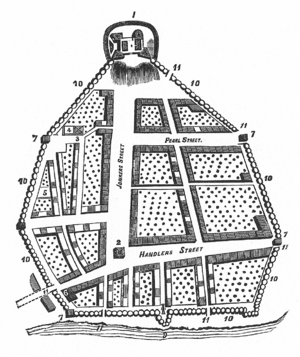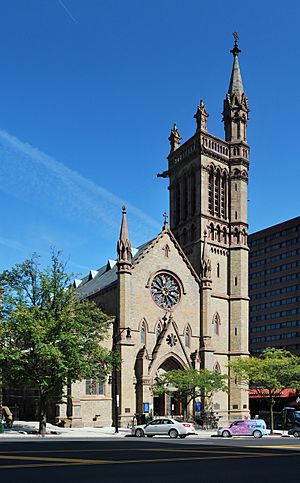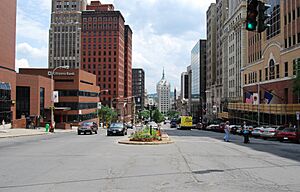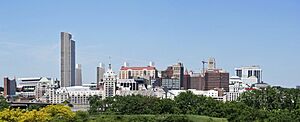Downtown Albany Historic District facts for kids
Quick facts for kids |
|
|
Downtown Albany Historic District
|
|
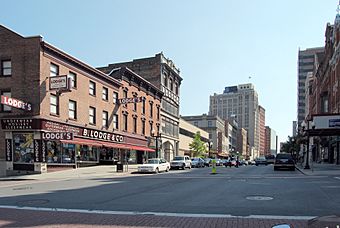
View north along North Pearl Street (NY 32), 2009
|
|
| Location | Broadway, State, Pine, Lodge and Columbia Sts., Albany, New York |
|---|---|
| Area | 66 acres (27 ha) |
| Architect | Multiple |
| Architectural style | Late 19th And 20th Century Revivals, Late Victorian |
| NRHP reference No. | 80002579 |
| Added to NRHP | January 31, 1980 |
The Downtown Albany Historic District is a special area in Albany, New York. It covers 19 city blocks and is about 66 acres big. This district is the oldest part of Albany, first settled way back in the 1600s. It's where the city really started to grow and become important.
In 1980, this area was officially named a historic district. This means its old buildings and unique history are protected. Most of the 160 buildings you see today were built between 1880 and 1930. Many of these buildings are tall commercial offices, while others are smaller homes. You can see some of Albany's first skyscrapers here!
The buildings show how rich Albany was during the Gilded Age. Many were built by banks or for the state government. Even though newer buildings like the Empire State Plaza are taller now, the Downtown Historic District still has many of its original buildings. This is because big city changes in the past didn't affect this area much.
Contents
Exploring Downtown Albany's Location
The Downtown Albany Historic District has a unique shape, a bit like a crescent moon. It's located around North and South Pearl streets (NY 32) and State Street (NY 5). This area is downhill from the Empire State Plaza and east of the state capitol building.
To the east, the district is next to the Hudson River. On its western side, it reaches Eagle Street. The northern boundary follows Columbia Street, then goes north to Sheridan Street. It continues east to North Pearl Street and then follows property lines to Broadway.
The southern part of the district goes inland to Pruyn Street. It then follows Liberty Street and Hudson Avenue. This area includes many streets like James, Steuben, and Maiden Lane. Most of the district is fully developed with tall office buildings and shops. There aren't many parks or open spaces here.
A Look Back: History of Downtown Albany
Downtown Albany has always been the heart of the city since it began in the 1600s. The buildings we see today mostly took shape in the late 1800s. Since then, the area has stayed pretty much the same.
Early Days: Colonial and Revolutionary Times
The area was first settled by the Dutch in the 1600s. It was a high spot between two ravines. In 1664, the British took over and renamed it Albany. This was to honor King James II, who was the Duke of Albany.
The streets were planned out in a grid pattern back then. Most of the early buildings were warehouses along what is now Broadway. The Coulson Building at 420 Broadway, built in 1815, is the oldest building in the district. It shows what those early buildings looked like.
Albany was important during the French and Indian War and the American Revolutionary War. After the Revolutionary War, the New York State Legislature met here. In 1797, Albany officially became the capital of New York State.
Growing Up: The 1800s in Albany
More homes were built in the 1800s, often rented to lawyers and lawmakers. The city grew and added nearby land. When the Erie Canal opened in the 1820s, Albany became a major transportation center. This made the city even more important for business and politics.
Smaller buildings were common on the side streets, with churches appearing next to them. Richard Upjohn designed St. Peter's Episcopal Church on State Street. It was finished in 1860 and is a beautiful example of French Gothic style. Another church, St. Mary's, became a central point for a neighborhood of small houses.
After the American Civil War, businesses started building taller buildings. These were on North Pearl and State streets. Edward Ogden designed the Kenmore Hotel in 1873. He also designed the Albany Business College building. Other architects added buildings in styles like Richardsonian Romanesque.
Modern Times: The 1900s in Albany
Marcus T. Reynolds was an Albany architect who designed many buildings in the district. His most famous is the 1914 headquarters for the Delaware and Hudson Railway. It looks like the Cloth Hall in Belgium and is a symbol of Albany. Many people think it's the state capitol!
This building is a key landmark when you look down State Street. Reynolds also designed the First Trust Company Building and the United Traction Company Building. These buildings also help guide your eye along Broadway.
Architects from New York City also built in Albany. The Home Savings Bank Building, finished in 1927, was the tallest building in Albany at the time. It was built in the Art Deco style. However, it was soon surpassed by the state government's Alfred E. Smith Building.
Building slowed down in the 1930s due to the Great Depression. After World War II, new construction moved to other parts of the city. Downtown Albany remained popular for politicians but started to decline in other ways.
In the late 1960s, there were plans to change downtown. These plans included closing some streets to cars and creating a large pedestrian area. However, these big changes mostly didn't happen. This was partly because the city's leaders preferred local control over federal funding.
Instead, a huge project called the "South Mall Project" was built southwest of downtown. This became the Empire State Plaza. It has five tall, modern state office buildings. When it was finished in the 1970s, it became the new center of Albany's skyline. The Delaware and Hudson Railway moved out of its building. The state later bought it for the State University of New York.
Recent Years: The 2000s in Albany
In the late 1980s, a developer wanted to tear down some historic buildings on State Street. People who wanted to protect old buildings objected. The project was later canceled. A decade later, a similar plan came up. This time, preservationists sued the city to stop the demolition.
The buildings got worse over time. In 2004, part of State Street had to be closed because a piece of the Wellington Hotel was in danger of falling. A new owner eventually found a way to save the important parts of the old buildings. They kept the fronts of the Wellington and other State Street buildings. New office buildings were built behind them.
Today, any new construction or changes in the district are reviewed by the city's Historic Resources Commission. This group helps make sure the historic character of the area is protected.
Important Buildings in the District
Many buildings in the Downtown Albany Historic District are very special. Six of them are listed on the National Register of Historic Places. One is even a National Historic Landmark!
National Historic Landmark
- St. Peter's Episcopal Church, 107 State Street. This church was finished in 1860. It's in the French Gothic style and is considered one of the best churches designed by Richard Upjohn. A British Lord, Lord Howe, is buried under the entrance. He is the only British Lord buried in the United States.
Buildings on the National Register of Historic Places
- Delaware and Hudson Railroad Company Building, Broadway and State Street. This building is now the main office for the State University of New York. It's the most famous building in downtown Albany. It was built in 1913 and might have been inspired by a 13th-century building in Belgium.
- James T. Foley United States Courthouse, 445 Broadway. This courthouse was built between 1931 and 1934 in the Art Deco style.
- Old Post Office, Broadway and State Street. This post office was built in 1883. Its design was a simpler version of a grander plan.
- First Trust Company Building, Broadway and State. This building was designed in 1902 in the classic Beaux Arts style.
- St. Mary's Church, 10 Lodge Street. Built in 1869, this was an early example of the Romanesque Revival style. When its tall tower was finished in the 1890s, it was the first church in Albany with electric lights.
- United Traction Company Building, Broadway and Columbia. This 1902 Beaux Arts building also helps guide your eye down Columbia Street.
- Van Ostrande–Radliff House. This is the oldest building in Albany. It was added to the Register in 2008.
- YMCA Building, 60 North Pearl. This building was designed in 1886 in the Richardsonian Romanesque style.
Other Cool Buildings to See
- Coulson Building, 420 Broadway. This warehouse was built in 1815. It's one of the oldest buildings in the district.
- Home Savings Bank Building. This 1927 Art Deco skyscraper was the tallest building in Albany when it was built.
- Kenmore Hotel, Columbia and North Pearl Street. This hotel, built in 1873, is the only 19th-century hotel in downtown that is still mostly original. It has been an office building since 1986.
- National State Bank Building, 60 State Street. This bank building from 1901 looks like a classical temple.
- R.B. Wing Building, 384 Broadway. This 1913 building brought the Dutch Colonial Revival style back to the district.
- Albany Masonic Temple. This is the oldest Masonic property in the United States that has been owned continuously by the Masons.




